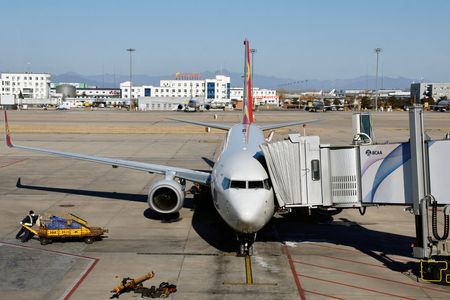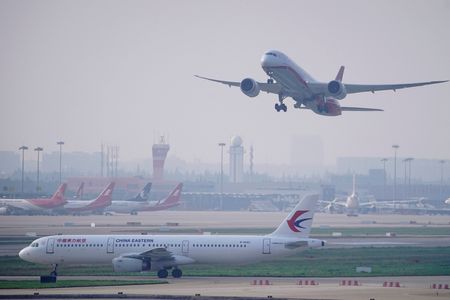By Jamie Freed and Sophie Yu
SYDNEY/BEIJING (Reuters) – Chinese airlines will be the early winners of the country’s international reopening, analysts say, having kept most widebody planes and staff ready while foreign carriers struggle with capacity constraints after previous border openings.
Less than one-fifth of China’s widebody fleet of about 500 planes is in storage, according to a McKinsey analysis using Cirium data, with most planes active but flying fewer hours than usual on domestic routes and limited international and cargo flights.
GRAPHIC: China’s widebody aircraft fleet (https://www.reuters.com/graphics/HEALTH-CORONAVIRUS/CHINA-AIRLINES/movakkanova/chart.png)
Chinese airlines also retained most pilots and cabin crew during the pandemic, and airports kept about 90% of their workers, a move that should help carriers avoid the chaotic ramp-up seen in North America and Europe, said Steve Saxon, a Shenzhen-based McKinsey partner who leads its Asia travel practice.
“The profitability is going to be good in the short term… because even if the Chinese carriers activate quite quickly, what we’ve seen around the world is the demand comes back faster than supply,” he said. “And that typically means that prices are therefore high.”
About 62% of tickets to and from China were sold by Chinese carriers and 38% by foreign carriers in 2019, ForwardKeys data shows, reflecting the strong outbound market dominating traffic flows.
State-owned Air China, China Southern Airlines and China Eastern Airlines received financial support during the pandemic and kept narrowbody planes active on domestic routes so the aircraft can be redeployed quickly to Asian destinations.
“The Chinese airlines have a front seat,” Singapore-based independent analyst Brendan Sobie said of the recovery, citing advantages including a large sales base in China and the ability to deploy capacity quickly on routes with the most demand.
“Foreign airlines don’t have that flexibility and it will be hard for them to forecast and project how fast demand returns on their China routes,” he added.
Many foreign carriers also retired large numbers of widebody planes during the pandemic and have struggled to add capacity even before China opened.
Carriers including Lufthansa, United Airlines, Singapore Airlines and Qantas Airways said this week they were examining their plans for China flights but did not announce immediate increases.
TIMING OF REBOUND
The Chinese travel industry had expected a border opening around March and was not prepared for the Jan. 8 date, according to a research note from Tianfeng Securities.
International flights to and from China are at just 8% of pre-pandemic levels, VariFlight data shows, and carriers require confirmation of traffic rights and airport slots as they look to ramp up capacity.
Ticket prices remain high, and other initial travel hurdles include an expected backlog of passport renewals and visa applications, as well as fresh testing requirements for Chinese travellers put in place by countries including the United States, Japan, India and Italy, Saxon said.
He expects international capacity to and from China will rise to about 20% to 30% of pre-pandemic levels by March and reach maybe 50% by summer.
For travel to China, a large market for business and leisure, July is the most searched month, according to Skyscanner data from this week provided to Reuters.
“From a pricing perspective, there may be some short-term fluctuations due to large amounts of demand, but we anticipate that airlines will mobilise aircraft and crews quickly and reintroduce capacity to keep prices attractive,” a Skyscanner spokesperson said.
(Reporting by Jamie Freed in Sydney and Sophie Yu in Beijing. Editing by Gerry Doyle)


